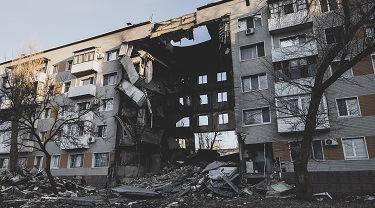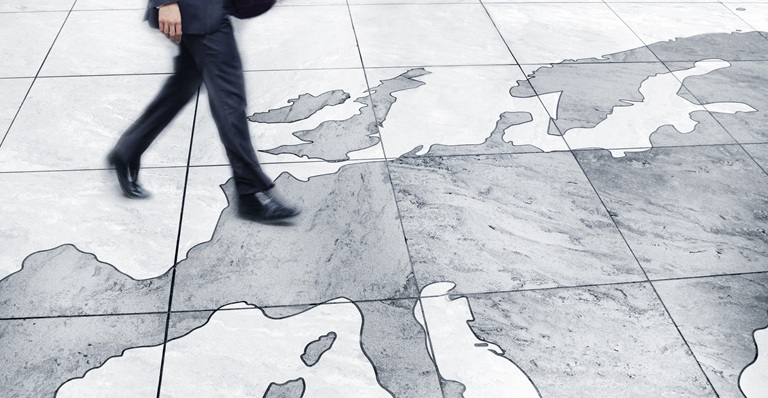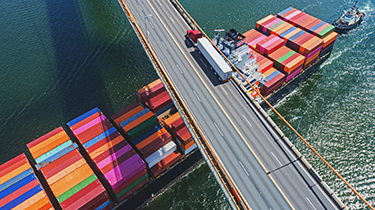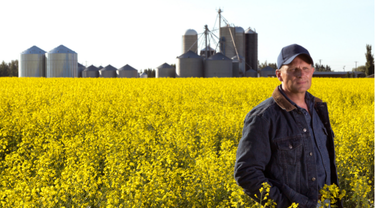It’s been 15 months since Russia launched its full-scale unprovoked and unjustifiable invasion of Ukraine, which has resulted in a massive loss of life and destruction, while the implications beyond these borders are undeniably alarming.
Russia and the North Atlantic Treaty Organization (NATO) find themselves in a heightened state of potential confrontation for the first time since the 1980s, with existential risks given the nuclear arsenals at each other’s disposal. The conflict has displaced more than 15 million Ukrainians, reportedly claimed more than 130,000 Ukrainian casualties (civilians and soldiers), and as many as 250,000 Russian soldiers (killed or wounded).
In addition to the human tragedy, the invasion has set off a chain reaction of events: From shattering Ukraine’s economy to disrupting international trade flows leading to higher commodity prices and damaging global prosperity and international relations. Since opening up to the West, the countries of Eastern Europe and the former Soviet Union had all experienced periods of stable and more rapid economic growth. New trade routes with the West set the stage for rising regional income and wealth. But the conventional cross-border war between these two major countries in Eastern Europe—an event not witnessed since the Second World War—has turned back the dial on progress.
Effects on the world
Prior to the war, the two countries were integral to meeting a large portion of the world’s energy, mineral, fertilizer and food demands. But the conflict has exacerbated the already fragile global economy with the disruption of the free movement of goods. Along with new sanctions and trade restrictions imposed by the West and Russia, the combined impact has stalled the natural East-West energy corridor. Meanwhile, farmers in Ukraine can’t till their fields or harvest crops without fear, while the transportation of goods to ports and shipping routes are often blocked, reducing the volume of all goods getting to international markets.
Inflation around the world has risen to generational highs since the outset of the conflict—as have food and energy costs—especially in Europe. According to the International Energy Agency, Russia had supplied 35% of the European Union’s (EU) crude oil imports and about 40% of its natural gas imports prior to the war. These trade volumes with the EU have all but ceased, which has led some commentators to conclude that the world is delinking due to the war.
You should also check out
EDC interactive tool offers economic insights on Canada’s Top 75 trading partners.
Pivoting for change
But the age of globalization isn’t over, as importers and exporters are building new trade routes seeking to “de-risk” supply chains. Notably, the United States and other energy producers have stepped up to fill most of the EU’s energy needs, while Russia has found new markets in Asia for its crude oil and natural gas. The EU, to its credit, has ramped up its green energy transition pace. This has allowed global energy price pressures to ease as sufficient volumes have made it to markets, albeit new markets.
Of course, not all goods can be replaced through new trade routes. Ukraine’s agricultural exports, in particular, face obstacles from the aerial bombardment of fields and transportation infrastructure to naval blockades. Prior to the war, Ukraine was the world’s:
- leading sunflower oil producer (28%);
- fifth-largest corn producer;
- fifth-largest wheat exporter;
- sixth-largest honey producer; and
- eighth-largest cereals producer.
But the war has disrupted production and trade, creating a regional and global food supply shock. Russia, too, is a significant global agricultural crop producer, but fortunately, its goods are still reaching most destination markets. However, Russia and Belarus combined produce roughly half of the world’s potash-based fertilizer and restricting international sales could complicate global crop supplies down the line.
At the start of the full-scale invasion on Feb. 24, 2022, most analysts felt that Russia would steam-roll across Ukraine and take full control of the country within weeks—if not days. But that hasn’t been the case. Ukraine’s army has proven resilient and quite capable of repelling the attack and is now on the cusp of an offensive push, which aims to retake land that was lost.
Don’t underestimate the underdog
In a recent survey conducted inside Ukraine, 97% of the respondents felt that their country would win the war, with three-quarters believing that Ukrainian troops would successfully restore all of the country’s internationally recognized borders. Of course, it’s impossible to forecast the outcome of any war due to the many permutations of actions and reactions that both combatant sides could take, not to mention the weather impact on events. Although fighting will likely continue over the near term, even if Ukraine can re-establish its territorial integrity, the country will need strong support once the war ends.
The economic and financial bill to repair the damages caused by the invasion will be enormous. The World Bank recently announced that infrastructure losses were closer to US$411 billion. But this says nothing of the lost economic output due to the war. The International Monetary Fund’s (IMF) most recent calculations indicate that Ukraine’s gross domestic product (GDP) contracted 30% in inflation-adjusted terms in 2022 and will most likely shrink 3% in 2023. And let’s not forget, that as with most wars, the unexploded ordinance will need removal and disposal once the fighting stops. The longer this war drags on, and accounting for these additional items, it’s easy to see that the final price tag to put things back on track as though the war never happened could drag on for years and hit the US$1-trillion mark.
Key takeaways
The lessons learned from the conflict are varied. The free movement of goods and services has been negatively impacted causing supply disruptions that have led to price spikes. Workarounds have been found for a good portion of the energy complex, but agricultural goods are more severely impacted, due to the location and nature of the conflict.
Economic growth in Ukraine has been hammered, which has created a cascade effect to regional economies and beyond. Damages to Ukraine’s infrastructure and personal property will be costly and take years to repair, while lost potential output may never recover. International relations between the West and Russia have been set back years—if not decades. But most importantly, the human cost, in terms of lost lives, can never be replaced.
Export Development Canada (EDC) provides many resources that exporters can use to monitor global risk. To explore these areas, please refer to our Knowledge Centre, solutions and Export Help Hub.
Richard Schuster is a longtime EDC senior economist and expert on Ukraine and other markets in Eastern Europe and Central Asia.







